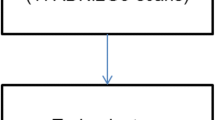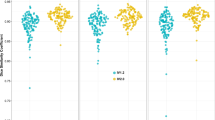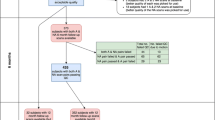Abstract
Introduction
Automated brain MRI morphometry, including hippocampal volumetry for Alzheimer disease, is increasingly recognized as a biomarker. Consequently, a rapidly increasing number of software tools have become available. We tested whether modifications of simple MR protocol parameters typically used in clinical routine systematically bias automated brain MRI segmentation results.
Methods
The study was approved by the local ethical committee and included 20 consecutive patients (13 females, mean age 75.8 ± 13.8 years) undergoing clinical brain MRI at 1.5 T for workup of cognitive decline. We compared three 3D T1 magnetization prepared rapid gradient echo (MPRAGE) sequences with the following parameter settings: ADNI-2 1.2 mm iso-voxel, no image filtering, LOCAL− 1.0 mm iso-voxel no image filtering, LOCAL+ 1.0 mm iso-voxel with image edge enhancement. Brain segmentation was performed by two different and established analysis tools, FreeSurfer and MorphoBox, using standard parameters.
Results
Spatial resolution (1.0 versus 1.2 mm iso-voxel) and modification in contrast resulted in relative estimated volume difference of up to 4.28 % (p < 0.001) in cortical gray matter and 4.16 % (p < 0.01) in hippocampus. Image data filtering resulted in estimated volume difference of up to 5.48 % (p < 0.05) in cortical gray matter.
Conclusion
A simple change of MR parameters, notably spatial resolution, contrast, and filtering, may systematically bias results of automated brain MRI morphometry of up to 4–5 %. This is in the same range as early disease-related brain volume alterations, for example, in Alzheimer disease. Automated brain segmentation software packages should therefore require strict MR parameter selection or include compensatory algorithms to avoid MR parameter-related bias of brain morphometry results.




Similar content being viewed by others
Abbreviations
- AD:
-
Alzheimer dementia
- ADNI:
-
Alzheimer Disease Neuroimaging Initiative
- cGM:
-
Cortical gray matter
- FDR :
-
False discovery rate
- GM :
-
Gray matter
- LOCAL :
-
Local imaging protocol with 1 mm iso-voxel resolution
- MCI :
-
Mild cognitive impairment
- MPRAGE :
-
Magnetization prepared rapid gradient echo
- MRI :
-
Magnetic resonance imaging
- TIV :
-
Total intracranial volume
References
Albert MS, DeKosky ST, Dickson D, Dubois B, Feldman HH, Fox NC, Gamst A, Holtzman DM, Jagust WJ, Petersen RC, Snyder PJ, Carrillo MC, Thies B, Phelps CH (2011) The diagnosis of mild cognitive impairment due to Alzheimer’s disease: recommendations from the National Institute on Aging-Alzheimer’s association workgroups on diagnostic guidelines for Alzheimer’s disease. Alzheimers Dement 7(3):270–279
McKhann GM, Knopman DS, Chertkow H, Hyman BT, Jack CR, Kawas CH, Klunk WE, Koroshetz WJ, Manly JJ, Mayeux R, Mohs RC, Morris JC, Rossor MN, Scheltens P, Carrillo MC, Thies B, Weintraub S, Phelps CH (2011) The diagnosis of dementia due to Alzheimer’s disease: recommendations from the National Institute on Aging-Alzheimer’s association workgroups on diagnostic guidelines for Alzheimer’s disease. Alzheimers Dement 7(3):263–269
Mueller SG, Weiner MW, Thal LJ, Petersen RC, Jack CR, Jagust W, Trojanowski JQ, Toga AW, Beckett L (2005) Ways toward an early diagnosis in Alzheimer’s disease: the Alzheimer’s Disease Neuroimaging Initiative (ADNI). Alzheimers Dement 1(1):55–66
Jack CR, Bernstein MA, Fox NC, Thompson P, Alexander G, Harvey D, Borowski B, Britson PJ, Whitwell LJ, Ward C, Dale AM, Felmlee JP, Gunter JL, Hill DL, Killiany R, Schuff N, Fox-Bosetti S, Lin C, Studholme C, DeCarli CS, Krueger G, Ward HA, Metzger GJ, Scott KT, Mallozzi R, Blezek D, Levy J, Debbins JP, Fleisher AS, Albert M, Green R, Bartzokis G, Glover G, Mugler J, Weiner MW (2008) The Alzheimer’s Disease Neuroimaging Initiative (ADNI): MRI methods. J Magn Reson Imaging 27(4):685–691
Jack CR, Bernstein MA, Borowski BJ, Gunter JL, Fox NC, Thompson PM, Schuff N, Krueger G, Killiany RJ, DeCarli CS, Dale AM, Carmichael OW, Tosun D, Weiner MW, Alzheimer’s Disease Neuroimaging Initiative (2010) Update on the Magnetic Resonance Imaging core of the Alzheimer’s Disease Neuroimaging Initiative. Alzheimer’s & Dementia: The Journal of the Alzheimer’s Association 6(3):212–220
Mortamet B, Bernstein MA, Jack CR, Gunter JL, Ward C, Britson PJ, Meuli R, Thiran JP, Krueger G, Alzheimer’s DNI (2009) Automatic quality assessment in structural brain magnetic resonance imaging. Magn Reson Med 62(2):365–372
Roche A, Ribes D, Bach-Cuadra M, Krüger G (2011) On the convergence of EM-like algorithms for image segmentation using Markov random fields. Med Image Anal 15(6):830–839
Schmitter D, Roche A, Maréchal B, Ribes D, Abdulkadir A, Bach-Cuadra M, Daducci A, Granziera C, Klöppel S, Maeder P, Meuli R, Krueger G, Alzheimer’s DNI (2015) An evaluation of volume-based morphometry for prediction of mild cognitive impairment and Alzheimer’s disease. Neuroimage Clin 7:7–17
Fischl B (2012) FreeSurfer. NeuroImage 62(2):774–781
Genovese CR, Lazar NA, Nichols T (2002) Thresholding of statistical maps in functional neuroimaging using the false discovery rate. NeuroImage 15(4):870–878
Jovicich J, Czanner S, Han X, Salat D, van der Kouwe A, Quinn B, Pacheco J, Albert M, Killiany R, Blacker D, Maguire P, Rosas D, Makris N, Gollub R, Dale A, Dickerson BC, Fischl B (2009) MRI-derived measurements of human subcortical, ventricular and intracranial brain volumes: reliability effects of scan sessions, acquisition sequences, data analyses, scanner upgrade, scanner vendors and field strengths. NeuroImage 46(1):177–192
Jovicich J, Czanner S, Greve D, Haley E, van der Kouwe A, Gollub R, Kennedy D, Schmitt F, Brown G, Macfall J, Fischl B, Dale A (2006) Reliability in multi-site structural MRI studies: effects of gradient non-linearity correction on phantom and human data. NeuroImage 30(2):436–443
Jovicich J, Marizzoni M, Sala-Llonch R, Bosch B, Bartrés-Faz D, Arnold J, Benninghoff J, Wiltfang J, Roccatagliata L, Nobili F, Hensch T, Tränkner A, Schönknecht P, Leroy M, Lopes R, Bordet R, Chanoine V, Ranjeva JP, Didic M, Gros-Dagnac H, Payoux P, Zoccatelli G, Alessandrini F, Beltramello A, Bargalló N, Blin O, Frisoni GB, PharmaCog C (2013) Brain morphometry reproducibility in multi-center 3 T MRI studies: a comparison of cross-sectional and longitudinal segmentations. NeuroImage 83:472–484
Wonderlick JS, Ziegler DA, Hosseini-Varnamkhasti P, Locascio JJ, Bakkour A, van der Kouwe A, Triantafyllou C, Corkin S, Dickerson BC (2009) Reliability of MRI-derived cortical and subcortical morphometric measures: effects of pulse sequence, voxel geometry, and parallel imaging. NeuroImage 44(4):1324–1333
Kruggel F, Turner J, Muftuler LT (2010) Impact of scanner hardware and imaging protocol on image quality and compartment volume precision in the ADNI cohort. NeuroImage 49(3):2123–2133
Morey RA, Selgrade ES, Wagner HR, Huettel SA, Wang L, McCarthy G (2010) Scan-rescan reliability of subcortical brain volumes derived from automated segmentation. Hum Brain Mapp 31(11):1751–1762
Reuter M, Schmansky NJ, Rosas HD, Fischl B (2012) Within-subject template estimation for unbiased longitudinal image analysis. NeuroImage 61(4):1402–1418
Falkovskiy P, Brenner D, Feiweier T, Kannengiesser S, Maréchal B, Kober T, Roche A, Thostenson K, Meuli R, Reyes D, Stoecker T, Bernstein MA, Thiran JP, Krueger G (2015) Comparison of accelerated T1-weighted whole-brain structural-imaging protocols. NeuroImage 124(Pt A):157–167
Frankó E, Joly O, Alzheimer’s DNI (2013) Evaluating Alzheimer’s disease progression using rate of regional hippocampal atrophy. PLoS One 8(8):e71354
Frisoni GB, Fox NC, Jack CR, Scheltens P, Thompson PM (2010) The clinical use of structural MRI in Alzheimer disease. Nat Rev Neurol 6(2):67–77
Cuingnet R, Gerardin E, Tessieras J, Auzias G, Lehéricy S, Habert MO, Chupin M, Benali H, Colliot O, Alzheimer’s DNI (2011) Automatic classification of patients with Alzheimer’s disease from structural MRI: a comparison of ten methods using the ADNI database. NeuroImage 56(2):766–781
Gronenschild EH, Habets P, Jacobs HI, Mengelers R, Rozendaal N, van Os J, Marcelis M (2012) The effects of FreeSurfer version, workstation type, and Macintosh operating system version on anatomical volume and cortical thickness measurements. PLoS One 7(6):e38234
Maclaren J, Han Z, Vos SB, Fischbein N, Bammer R (2014) Reliability of brain volume measurements: a test-retest dataset. Sci Data 1140037
Author information
Authors and Affiliations
Corresponding author
Ethics declarations
We declare that all human and animal studies have been approved by the Geneva University Ethics Committee and have therefore been performed in accordance with the ethical standards laid down in the 1964 Declaration of Helsinki and its later amendments. We declare that the ethics committee waived individual patient consent.
Conflict of interest
TK, BM, GK, and AR are full-time or part-time employees of Siemens Healthcare AG.
Additional information
SH and PF contributed equally to this work.
Rights and permissions
About this article
Cite this article
Haller, S., Falkovskiy, P., Meuli, R. et al. Basic MR sequence parameters systematically bias automated brain volume estimation. Neuroradiology 58, 1153–1160 (2016). https://doi.org/10.1007/s00234-016-1737-3
Received:
Accepted:
Published:
Issue Date:
DOI: https://doi.org/10.1007/s00234-016-1737-3




